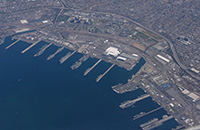San Diego Naval Shipyard
The San Diego Naval Shipyard, whose official name is the Naval Base San Diego, currently occupies 97 acres and is home to 56 U.S. ships (both Naval and privately owned), two U.S. Coast Guard cutters, and Military Sealife Command ships.

The San Diego Naval Shipyard has been around since 1918, but it was busiest between 1943 and 1950. During this time, the base expanded to over 1,100 acres. At its peak, 14,000 people worked at the yard.
In October 1943, the shipyard became a repair base for the Navy. During World War II, it worked on more than 5,117 ships including cruisers, destroyers and submarines. After the war ended, they carried on with fixing and offering dry-docking services.
The San Diego Shipyard also offered classes to help enlisted personnel learn how to use equipment. During this training, they were exposed to asbestos as well as other contaminants.
A Navy Investigation Uncovers Suspected Asbestos Contamination
According to Navy documentation dated May 10, 2006, a number of locations in the shipyard were contaminated with asbestos material. The Salvage Yard contained demolition debris from repairs made on the vessels that came into the yard for maintenance. It also contained PCB transformers, mercury, old batteries and solvents.
Site 10, another location where asbestos was found, was a material storage area in use from 1939 to the mid-1950s. In addition, Building 321 on Site 10 was constructed for metal finishing, and solvents and corrosives may have been used to clean metal materials.
Dry dock and ship repair wastes were temporarily stored in the Naval Station Steadfast Waste Storage Area without placing them in a secondary container. This storage area was 20 feet away from a storm drain where water could have become contaminated with asbestos fibers.
Naval Supply Center Building 3302 Temporary Storage Area was designated as a short-term storage facility for vehicle maintenance materials, many of which contained asbestos. This facility was also used for food storage.
The amount of asbestos in the shipyard could have exposed workers to moderate or high concentrations of asbestos.
In 2017, a study was published in the Archives of Environmental & Occupational Health. It evaluated the risk of mesothelioma among shipyard workers. Those exposed to a moderate amount of asbestos were about four times more likely to die of mesothelioma. Those exposed to a high amount were seven times more likely to get mesothelioma.

Learn about your diagnosis, top doctors and how to pay for treatment.
Get Your Free GuideCleaning Up Contaminated Sites
A September 2009 report noted that 19 Installation Restoration Program (IRP) sites containing various kinds of contamination have been identified since 1986 when the Navy first started investigating conditions at the San Diego Navy Yard. Seven of these sites have been cleaned up or placed under the jurisdiction of another regulatory program, which handled the kind of cleanup needed to restore the location.
IRP Site 6, Murphy Canyon Naval Housing, was completed in July 2009 when the Navy implemented land use controls to protect individuals from the health risks associated with the possible presence of contaminants resulting from the location’s former use as a military range.
The other 11 sites remain open and in various stages of the cleanup process outlined under the Comprehensive Environmental Response, Compensation, and Liability Act (CERCLA).
Recommended Reading


